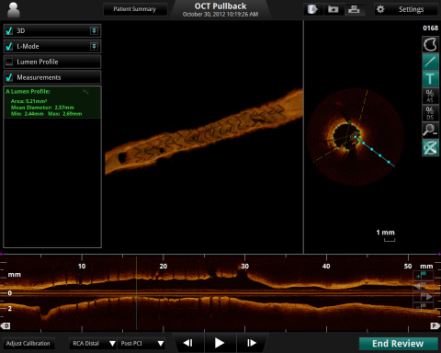St Jude Medical's 3D coronary artery imaging system for stent placement gains EU approval
22 May 2013
St Jude Medical has announced it has been granted CE Mark approval for its Ilumien Optis PCI Optimization System, a coronary artery disease (CAD) assessment tool.
The Ilumien Optis system provides enhancements to the Ilumien
system, including stent planning software tools to aid in the
treatment of CAD. The platform integrates both Fractional Flow
Reserve (FFR) technology to measure pressure inside the coronary
arteries and intravascular Optical Coherence Tomography (OCT)
imaging technology, in one system.
Featuring a faster,
high-powered laser, the system offers twice the resolution for
microscopic examination of disease inside the artery to assist with
stent placement. The real-time, three-dimensional (3-D)
reconstruction offers a 360-degree panoramic view of the vessel,
making it easier for physicians to visualize the area they are
treating. St. Jude Medical says it is the only company to provide
these tools together in an integrated platform.

3D image of a stent inside a coronary artery taken
using the
Ilumien Optis. Source: St Jude Medical
“OCT technology has become increasingly important to help diagnose and treat patients with coronary artery disease. The Ilumien Optis system is a significant advancement in intravascular imaging technology allowing physicians to comprehensively assess more vessel in less time and more easily plan their PCI procedure. The three-dimensional format of the Ilumien Optis system provides a more true-to-life perspective of the arteries, which allows for individual decision making and precise guidance of stent placement to optimize coronary interventions," said Dr. Giulio Guagliumi, Cardiovascular Department of Ospedale Papa Giovanni XXIII, Bergamo, Italy.
Commonly known as coronary angioplasty, Percutaneous Coronary Intervention (PCI) is a non-surgical procedure used to treat narrowed coronary arteries of the heart found in patients with CAD.
The OCT technology in the system uses the Dragonfly Duo Imaging Catheter to capture near-infrared light imaging and measure important vessel characteristics otherwise invisible or difficult to assess with older imaging technology. When used with the Ilumien Optis system, the Dragonfly Duo catheter offers faster, longer pull-backs, which allow the physician to assess more of the patient’s artery in less time.
The wireless PressureWire Aeris technology that is integrated into the platform measures pressure differences in blood flow within the coronary arteries leading to the heart, and determines the severity of any narrowings or blockages. The FFR pressure guidewire is directed along the vessel, taking measurements as the guidewire is pulled back through the artery. Knowing which specific blockages are causing the patient’s blood flow to be ineffective helps guide the interventional cardiologist in determining which lesions warrant stenting, resulting in improved patient outcomes and reduced health care costs.
The FFR and OCT measurements allow doctors to more easily differentiate plaque build-up and determine if the narrowed arteries are causing ischemia (a restriction in blood flow), ultimately assisting in stent placement. The automated stent planning tools provide immediate information for assessment and real-time analysis, which is intended to streamline workflow, potentially helping physicians diagnose their patients more quickly